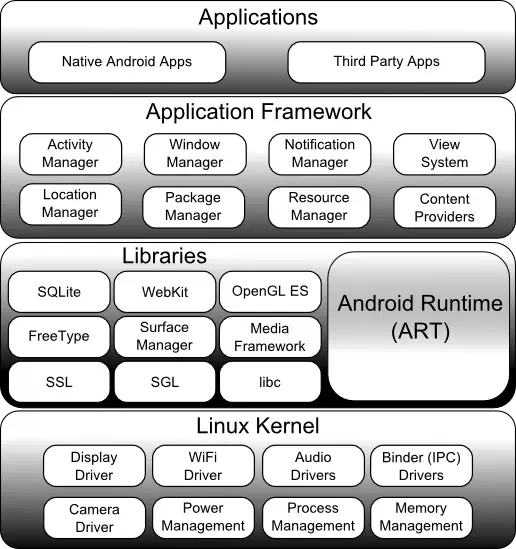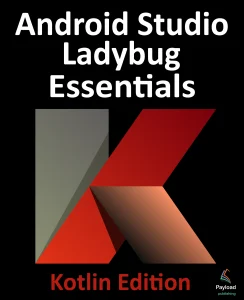So far, in this book, steps have been taken to set up an environment suitable for developing Android applications using Android Studio. An initial step has also been taken into the application development process by creating an Android Studio application project.
However, before delving further into the practical matters of Android application development, it is essential to understand some of the more abstract concepts of both the Android SDK and Android development in general. Gaining a clear understanding of these concepts now will provide a sound foundation on which to build further knowledge.
Starting with an overview of the Android architecture in this chapter and continuing in the following few chapters of this book, the goal is to provide a detailed overview of the fundamentals of Android development.
The Android Software Stack
Android is structured as a software stack comprising applications, an operating system, a runtime environment, middleware, services, and libraries. This architecture can best be represented visually, as Figure 9-1 outlines. Each layer of the stack, and the corresponding elements within each layer, are tightly integrated and carefully tuned to provide the optimal application development and execution environment for mobile devices. The remainder of this chapter will work through the different layers of the Android stack, starting at the bottom with the Linux Kernel.

The Linux Kernel
Positioned at the bottom of the Android software stack, the Linux Kernel provides a level of abstraction between the device hardware and the upper layers of the Android software stack. The kernel provides preemptive multitasking, low-level core system services such as memory, process, and power management, and a network stack and device drivers for hardware such as the device display, WiFi, and audio.
The original Linux kernel was developed in 1991 by Linus Torvalds. It was combined with a set of tools, utilities, and compilers developed by Richard Stallman at the Free Software Foundation to create a complete operating system called GNU/Linux. Various Linux distributions have been derived from these basic underpinnings, such as Ubuntu and Red Hat Enterprise Linux.
However, it is important to note that Android uses only the Linux kernel. That said, it is worth noting that the Linux kernel was originally developed for use in traditional desktop and server computer systems. In fact, Linux is now most widely deployed in mission-critical enterprise server environments. It is a testament to both the power of today’s mobile devices and the efficiency and performance of the Linux kernel that we find this software at the heart of the Android software stack.
Android Runtime – ART
When an Android app is built within Android Studio, it is compiled into an intermediate bytecode format (DEX format). When the application is subsequently loaded onto the device, the Android Runtime (ART) uses a process referred to as Ahead-of-Time (AOT) compilation to translate the bytecode down to the native instructions required by the device processor. This format is known as Executable and Linkable Format (ELF).
Each time the application is subsequently launched, the ELF executable version is run, resulting in faster application performance and improved battery life.
This contrasts with the Just-in-Time (JIT) compilation approach used in older Android implementations, whereby the bytecode was translated within a virtual machine (VM) each time the application was launched.
Android Libraries
In addition to a set of standard Java development libraries (providing support for such general-purpose tasks as string handling, networking, and file manipulation), the Android development environment also includes the Android Libraries. These are a set of Java-based libraries that are specific to Android development. Examples of libraries in this category include the application framework libraries in addition to those that facilitate user interface building, graphics drawing, and database access.
A summary of some key core Android libraries available to the Android developer is as follows:
- android.app – Provides access to the application model and is the cornerstone of all Android applications.
- android.content – Facilitates content access, publishing, and messaging between applications and application components.
- android.database – Used to access data published by content providers and includes SQLite database management classes.
- android.graphics – A low-level 2D graphics drawing API including colors, points, filters, rectangles, and canvases.
- android.hardware – Presents an API providing access to hardware such as the accelerometer and light sensor.
- android.opengl – A Java interface to the OpenGL ES 3D graphics rendering API.
- android.os – Provides applications with access to standard operating system services, including messages, system services, and inter-process communication.
- android.media – Provides classes to enable playback of audio and video.
- android.net – A set of APIs providing access to the network stack. Includes android.net.wifi, which provides access to the device’s wireless stack.
- android.print – Includes a set of classes that enable content to be sent to configured printers from within Android applications.
- android.provider – A set of convenience classes that provide access to standard Android content provider databases such as those maintained by the calendar and contact applications.
- android.text – Used to render and manipulate text on a device display.
- android.util – A set of utility classes for performing tasks such as string and number conversion, XML handling and date and time manipulation.
- android.view – The fundamental building blocks of application user interfaces.
- android.widget – A rich collection of pre-built user interface components such as buttons, labels, list views, layout managers, radio buttons etc.
- android.webkit – A set of classes intended to allow web-browsing capabilities to be built into applications.
Having covered the Java-based libraries in the Android runtime, it is now time to turn our attention to the C/C++-based libraries in this layer of the Android software stack.
C/C++ Libraries
The Android runtime core libraries outlined in the preceding section are Java-based and provide the primary APIs for Android developers. It is important to note, however, that the core libraries do not perform much of the actual work and are, in fact, essentially Java “wrappers” around a set of C/C++-based libraries. When making calls, for example, to the android.opengl library to draw 3D graphics on the device display, the library ultimately makes calls to the OpenGL ES C++ library, which, in turn, works with the underlying Linux kernel to perform the drawing tasks.
C/C++ libraries are included to fulfill a broad and diverse range of functions, including 2D and 3D graphics drawing, Secure Sockets Layer (SSL) communication, SQLite database management, audio and video playback, bitmap and vector font rendering, display subsystem and graphic layer management and an implementation of the standard C system library (libc).
In practice, the typical Android application developer will access these libraries solely through the Java-based Android core library APIs. If direct access to these libraries is needed, this can be achieved using the Android Native Development Kit (NDK), the purpose of which is to call the native methods of non-Java or Kotlin programming languages (such as C and C++) from within Java code using the Java Native Interface (JNI).
Application Framework
The Application Framework is a set of services that collectively form the environment in which Android applications run and are managed. This framework implements the concept that Android applications are constructed from reusable, interchangeable, and replaceable components. This concept is taken a step further in that an application can also publish its capabilities along with any corresponding data so that other applications can find and reuse them.
The Android framework includes the following key services:
- Activity Manager – Controls all aspects of the application lifecycle and activity stack.
- Content Providers – Allows applications to publish and share data with other applications.
- Resource Manager – Provides access to non-code embedded resources such as strings, color settings, and user interface layouts.
- Notifications Manager – Allows applications to display alerts and notifications to the user.
- View System – An extensible set of views used to create application user interfaces.
- Package Manager – The system by which applications can find information about other applications currently installed on the device.
- Telephony Manager – Provides information to the application about the telephony services available on the device, such as status and subscriber information.
- Location Manager – Provides access to the location services allowing an application to receive updates about location changes.
Applications
Located at the top of the Android software stack are the applications. These comprise the native applications provided with the particular Android implementation (for example, web browser and email applications) and the third-party applications installed by the user after purchasing the device.
Summary
A good Android development knowledge foundation requires an understanding of the overall architecture of Android. Android is implemented as a software stack architecture consisting of a Linux kernel, a runtime environment, corresponding libraries, an application framework, and a set of applications. Applications are predominantly written in Java or Kotlin and compiled into bytecode format within the Android Studio build environment. When the application is subsequently installed on a device, this bytecode is compiled down by the Android Runtime (ART) to the native format used by the CPU. The key goals of the Android architecture are performance and efficiency, both in application execution and in the implementation of reuse in application design.

